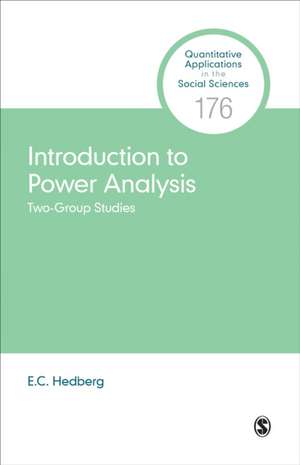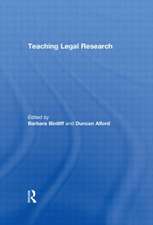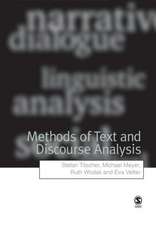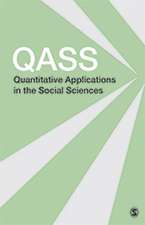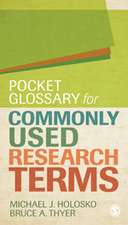Introduction to Power Analysis: Two-Group Studies: Quantitative Applications in the Social Sciences, cartea 176
Autor E. C. Hedbergen Limba Engleză Paperback – 27 feb 2018
Din seria Quantitative Applications in the Social Sciences
-
 Preț: 323.09 lei
Preț: 323.09 lei -
 Preț: 285.10 lei
Preț: 285.10 lei -
 Preț: 285.33 lei
Preț: 285.33 lei -
 Preț: 274.06 lei
Preț: 274.06 lei -
 Preț: 285.37 lei
Preț: 285.37 lei -
 Preț: 321.52 lei
Preț: 321.52 lei -
 Preț: 330.81 lei
Preț: 330.81 lei -
 Preț: 322.61 lei
Preț: 322.61 lei -
 Preț: 321.79 lei
Preț: 321.79 lei -
 Preț: 323.15 lei
Preț: 323.15 lei -
 Preț: 273.46 lei
Preț: 273.46 lei -
 Preț: 275.42 lei
Preț: 275.42 lei -
 Preț: 277.33 lei
Preț: 277.33 lei -
 Preț: 322.06 lei
Preț: 322.06 lei -
 Preț: 286.18 lei
Preț: 286.18 lei -
 Preț: 285.71 lei
Preț: 285.71 lei -
 Preț: 322.06 lei
Preț: 322.06 lei -
 Preț: 321.52 lei
Preț: 321.52 lei -
 Preț: 322.30 lei
Preț: 322.30 lei -
 Preț: 285.47 lei
Preț: 285.47 lei -
 Preț: 322.61 lei
Preț: 322.61 lei -
 Preț: 321.79 lei
Preț: 321.79 lei -
 Preț: 323.15 lei
Preț: 323.15 lei -
 Preț: 323.36 lei
Preț: 323.36 lei -
 Preț: 322.41 lei
Preț: 322.41 lei -
 Preț: 323.42 lei
Preț: 323.42 lei -
 Preț: 322.61 lei
Preț: 322.61 lei -
 Preț: 284.99 lei
Preț: 284.99 lei -
 Preț: 285.47 lei
Preț: 285.47 lei -
 Preț: 284.99 lei
Preț: 284.99 lei -
 Preț: 289.18 lei
Preț: 289.18 lei -
 Preț: 287.82 lei
Preț: 287.82 lei -
 Preț: 316.12 lei
Preț: 316.12 lei -
 Preț: 288.96 lei
Preț: 288.96 lei -
 Preț: 316.71 lei
Preț: 316.71 lei -
 Preț: 314.98 lei
Preț: 314.98 lei -
 Preț: 317.26 lei
Preț: 317.26 lei -
 Preț: 314.60 lei
Preț: 314.60 lei -
 Preț: 289.95 lei
Preț: 289.95 lei -
 Preț: 289.18 lei
Preț: 289.18 lei -
 Preț: 315.36 lei
Preț: 315.36 lei -
 Preț: 314.98 lei
Preț: 314.98 lei -
 Preț: 314.38 lei
Preț: 314.38 lei -
 Preț: 316.33 lei
Preț: 316.33 lei -
 Preț: 316.51 lei
Preț: 316.51 lei -
 Preț: 314.76 lei
Preț: 314.76 lei -
 Preț: 288.41 lei
Preț: 288.41 lei -
 Preț: 316.51 lei
Preț: 316.51 lei
Preț: 324.23 lei
Nou
Puncte Express: 486
Preț estimativ în valută:
62.04€ • 66.34$ • 51.73£
62.04€ • 66.34$ • 51.73£
Carte tipărită la comandă
Livrare economică 17 aprilie-01 mai
Preluare comenzi: 021 569.72.76
Specificații
ISBN-13: 9781506343129
ISBN-10: 1506343120
Pagini: 160
Dimensiuni: 140 x 216 x 9 mm
Greutate: 0.32 kg
Ediția:1
Editura: SAGE Publications
Colecția Sage Publications, Inc
Seria Quantitative Applications in the Social Sciences
Locul publicării:Thousand Oaks, United States
ISBN-10: 1506343120
Pagini: 160
Dimensiuni: 140 x 216 x 9 mm
Greutate: 0.32 kg
Ediția:1
Editura: SAGE Publications
Colecția Sage Publications, Inc
Seria Quantitative Applications in the Social Sciences
Locul publicării:Thousand Oaks, United States
Recenzii
“Introduction to Power Analysis provides detailed coverage of the topic in a succinct and concise way. Graduate students and others (including faculty who are also researchers) can benefit from this resource as it outlines the steps to conduct and evaluate power analysis to produce rigorous quantitative research in the social sciences, as well as why power analysis and effects are important to understand and apply in research.”
“Although there are a number of software programs available for power analysis, this volume teaches the reader how to employ power analysis using a popular software program (R) that can also be used to perform the desired statistical analyses on the data.”
“Although there are a number of software programs available for power analysis, this volume teaches the reader how to employ power analysis using a popular software program (R) that can also be used to perform the desired statistical analyses on the data.”
Cuprins
Chapter 1: The what, why, and when of power analysis
What is statistical power?
Why should power be a consideration when planning studies?
When should you perform a power analysis?
Significance and Effect 8
What do you need to know to perform a power analysis?
The structure of the volume
Chapter 2: Statistical distributions
Normally distributed random variables
The x^2 distribution
The t distribution
The F distribution
F to t
Chapter 3: General topics in hypothesis testing and power analysis when the population standard deviation is known: the case of two group means
The difference in means as a normally distributed random variable when the population standard deviation is known
Hypothesis testing with the difference between two group means when the population standard deviation is known
Power analysis for testing the difference between two group means when the population standard deviation is known
Scale-free parameters
Balance or unbalanced?
Types of power analyses
Power tables
Chapter 4: The difference between two groups in simple random samples where the population standard deviation must be estimated
Data generating process
Testing the difference between group means with samples
Power analysis for samples without covariates
Chapter 5: Using covariates when testing the difference in sample group means for balanced designs
Example analysis
Tests employing a covariate (ANCOVA) with balanced samples
Power analysis with a covariate correlated with the treatment indicator
Power analysis with a covariate uncorrelated to the treatment indicator
Chapter 6: Multilevel Models I: Testing the difference in group means in two-level cluster randomized trials
Example data
Understanding the single level test as an ANOVA
The hierarchical mixed model for cluster randomized trials
Power parameters for cluster randomized trials
Example analysis of a cluster randomized trial
Power analyses for cluster randomized trials
Chapter 7: Multilevel Models II: Testing the difference in group means in two-level multisite randomized trials
Power parameters for multisite randomized trials
Example analysis of a multisite randomized trial
Power analyses for multisite randomized trails
Chapter 8: Reasonable assumptions
Power analyses are arguments
Strategies for using the literature to make reasonable assumptions
Chapter 9: Writing about power
What to include
Examples
Chapter 10: Conclusions, further reading, and regression
The case study of comparing two groups
Further reading
Observational regression
What is statistical power?
Why should power be a consideration when planning studies?
When should you perform a power analysis?
Significance and Effect 8
What do you need to know to perform a power analysis?
The structure of the volume
Chapter 2: Statistical distributions
Normally distributed random variables
The x^2 distribution
The t distribution
The F distribution
F to t
Chapter 3: General topics in hypothesis testing and power analysis when the population standard deviation is known: the case of two group means
The difference in means as a normally distributed random variable when the population standard deviation is known
Hypothesis testing with the difference between two group means when the population standard deviation is known
Power analysis for testing the difference between two group means when the population standard deviation is known
Scale-free parameters
Balance or unbalanced?
Types of power analyses
Power tables
Chapter 4: The difference between two groups in simple random samples where the population standard deviation must be estimated
Data generating process
Testing the difference between group means with samples
Power analysis for samples without covariates
Chapter 5: Using covariates when testing the difference in sample group means for balanced designs
Example analysis
Tests employing a covariate (ANCOVA) with balanced samples
Power analysis with a covariate correlated with the treatment indicator
Power analysis with a covariate uncorrelated to the treatment indicator
Chapter 6: Multilevel Models I: Testing the difference in group means in two-level cluster randomized trials
Example data
Understanding the single level test as an ANOVA
The hierarchical mixed model for cluster randomized trials
Power parameters for cluster randomized trials
Example analysis of a cluster randomized trial
Power analyses for cluster randomized trials
Chapter 7: Multilevel Models II: Testing the difference in group means in two-level multisite randomized trials
Power parameters for multisite randomized trials
Example analysis of a multisite randomized trial
Power analyses for multisite randomized trails
Chapter 8: Reasonable assumptions
Power analyses are arguments
Strategies for using the literature to make reasonable assumptions
Chapter 9: Writing about power
What to include
Examples
Chapter 10: Conclusions, further reading, and regression
The case study of comparing two groups
Further reading
Observational regression
Notă biografică
E. C. Hedberg is a Senior Associate at Abt Associates. Previously he was a Senior Research Scientist at NORC at the University of Chicago. He received his undergraduate degree in Sociology from the University of Minnesota and his PhD in Sociology from the University of Chicago. His work is primarily focused on estimating design parameters useful for power analysis, multilevel modeling, social capital theory, and evaluation research.
Descriere
Introduction to Power Analysis: Two-Group Studies provides readers with the background, examples, and explanation they need to read technical papers and materials that include complex power analyses. This clear and accessible guide explains the components of test statistics and their sampling distributions, and author Eric Hedberg walks the reader through the simple and complex considerations of this research question.
